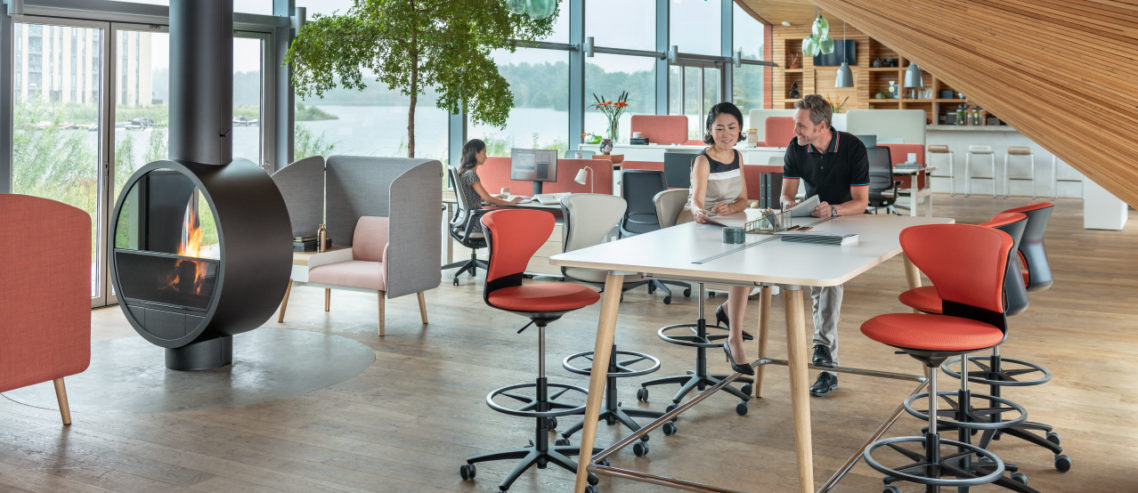Ethical behaviour and better ideas are linked to great office design
We’ve reported before on What’s Up about the important role of office design in nurturing individual wellbeing and bringing people together to collaborate. However, sophisticated the collaborative technology we have at our disposal, it always turns out that certain behaviours and ideas can best (and sometimes only) be nurtured in physical space.
This goes for more than how we exchange information and develop relationships with coworkers however. As two recent studies from Dutch researchers at the Rotterdam School of Management show, physical proximity and office design is also essential as a way of developing ethical standards across an organisation and of improving the experience of customers and so enhancing a firm’s profitability and competitiveness.
According to the first study, published in the Journal of Management, and carried out by a team from Rotterdam School of Management, Erasmus University and Cambridge University, the propensity for middle managers to mirror the management styles and ethical attitudes and behaviour of their superiors is closely linked to their physical proximity.
Conversely, middle managers, who are unfairly treated by their bosses, will treat their employees more fairly if they are based in different offices or buildings from their own managers. The researchers, led by Dr. Gijs van Houwelingen, claim that physical distance provides a form of ‘insulation’ against the influence of unethical behaviour and unfairness.
According to the report, distance refers to physical proximity or remoteness such as sharing an office, sitting at adjacent desks, being on the same floor or in the same building or on an equivalent hierarchical level. It can also refer to psychological or social distance; having empathy for someone, being able to relate to that person, or feeling part of the same team. The research confirms that physical and psychological distance are often closely interlinked.
The study confirms that the ideal scenario is one in which the senior levels of management display high standards of ethical behaviour and fairness and that the office is designed in such a way that every layer of the organisation works in close psychological and physical proximity to ensure that the behaviour becomes part of the organisation’s DNA.
The link with digital space
While this study confirms the link between the cultural and physical workplace, the second explores the link between the office and the digital spaces in which people work. It concludes that, in an era of flexible working, in which the digital workplace is just as important as the physical office, organisations that create spaces, technologies and networks focused on encouraging more collaborative work, perform better than their direct competitors. They also show improved levels of employee connectedness and responsive leadership.
The study, The Distance Dilemma : the effect of flexible working practices on performance in the digital workplace, led by Nick van der Meulen of Rotterdam School of Management, Erasmus University (RSM) and MIT’s Center for Information Systems Research (CISR) looked at five indicators, including growth in market share, profit growth and employee satisfaction to explore their correlation with specific working cultures.
The survey of 313 organisations showed that the high-performing organisations display more trust in employees, offer them greater autonomy and also have an integrated and company-wide approach to greater employee connectedness in both physical and digital space.
“Connectivity built across silos rather than in an isolated fashion is critical to empowering employees to provide seamless customer experiences,” van der Meulen explains. ““The end result is that they empower employees to make decisions in the best interest of customer experience and their work.”
In other words: a physical and digital work environment designed for a collaborative, integrated employee experience enables the delivery of more complex customer solutions. In addition, leaders in high-performing companies facilitate how people use the workplace rather than direct it.
They articulate a vision that links office design to the organisation’s strategic objectives. They encourage experimentation with new approaches to work, have a high tolerance for failure of new ideas and provide continuous learning opportunities. In other words the office should always be the stage set and not the play itself.
In terms of leadership style, high performers adopt an approach in which managers trust their employees to decide when, where, and how best to work, perhaps by offering them a range of democratically designed spaces in which to work and then allowing them to make their own decisions about how to use them. Staff are allowed to be flexible, and the whole organisation gets more competitive and better at learning and innovation.
